AMERICAN BRILLIANT CUT GLASS PUNCH BOWL & Pedestal ABP RAJAH BY PITKIN & BROOKS
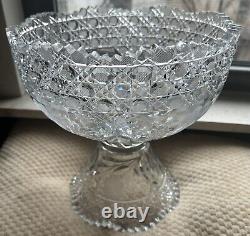
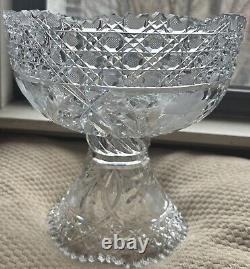

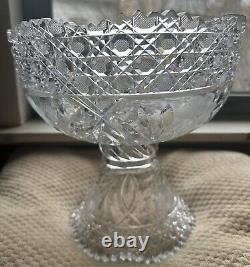
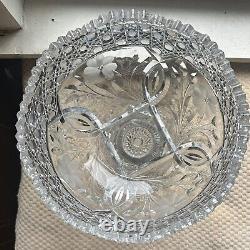
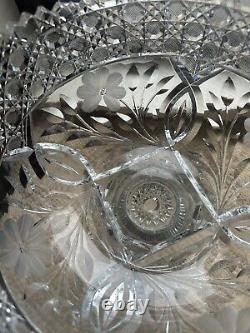
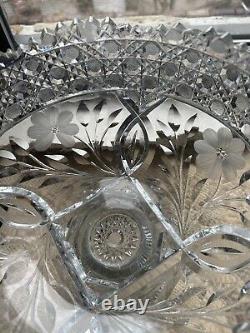
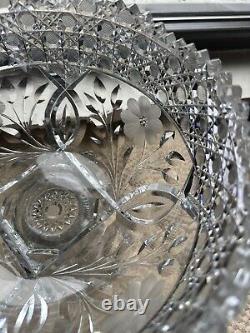
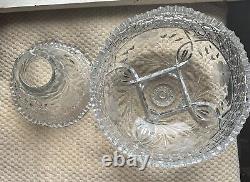
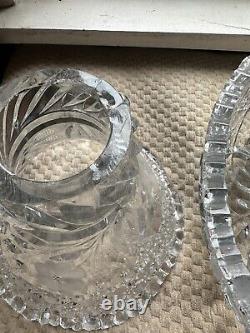
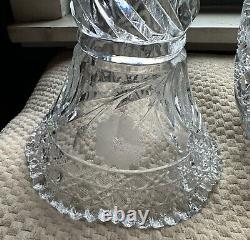
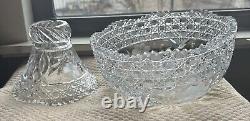
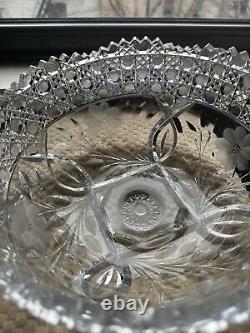
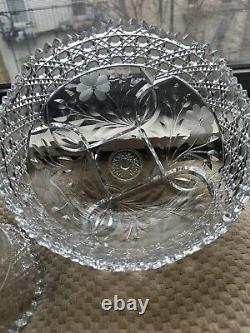
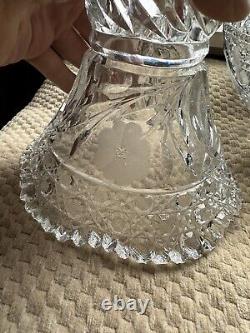
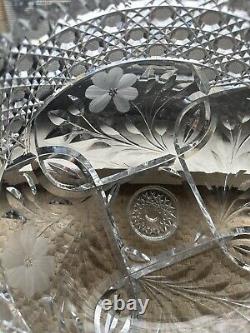


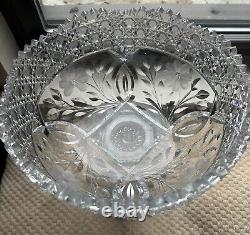

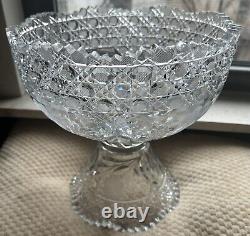
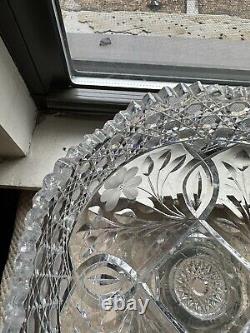
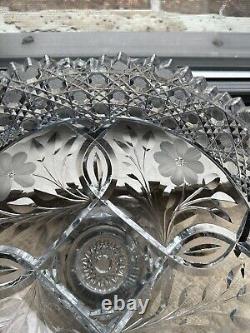
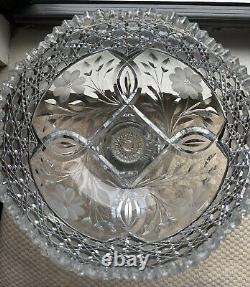

This is a beautiful and very heavy cut crystal or cut glass punchbowl and separate base. The punchbowl has a sawtooth rim with a scalloped design. The cut designs are a floral shape.
The glass is a very thick 3/8 wide. The punchbowl assembled is 10 high. By 20 wide at the rim.By 7 wide at base. Please note that the bowl had a.
A few tiny chips on top rim it's more felt that seem. Has very tiny chips on base not visible and chip on top rim not visible when assembled.Minor ding on a saw tooth hear and there. But would really have to look to find. The bowl was designated as fancy by P&B as it has a rim which flares in slightly creating a globe-like effect. The cutting and blank are of exceptional quality and shines beautifully. This 1890's American Victorian Clear Brilliant Cut Glass Two-Piece Punch Bowl on Stand in magnificent as Orchid (or any other plant) planter and you can enjoy looking at it all day long.
Today, punch bowls are regularly found stored high above a kitchen's countertop, among the silver in a butler's pantry, or with the linens in an overstuffed. Dating back to the early 1600s in India, punch bowls were found in middle class households, church halls, mansions, pubs, and taverns alike. Punch bowls were owned by anyone who liked a party and one's social status was noted by the number of different punch bowls that you owned.
Punch is a catch all term for cool drinks made with fruit, a beer alternative. Here comes the punch bowl. The 1876 Centennial Exposition in Philadelphia marked the beginning of a new era in American decorative arts history. Our country had proven it was strong enough to face the challenges of a fledgling nation and after 100 years, was just beginning to form its own identity. A major attraction at the Exposition was an exhibit that featured the best of what had come to be known as American rich-cut glass. Never before had the public seen such extraordinary wares created by American craftsmen. From this moment, the bar had been raised, as artisans around the globe realized that the United States had proven, once again, that it had what it took to forever change the world's perception of its fortitude, this time in the arena of the decorative arts. Prior to this, the most revered cut glass makers were in Europe, including masters of colored glass and later pioneers of art glass like Rene Lalique where artisans built upon a tradition that was already over 3,000 years old.In the 18th century, many people saw an opportunity for a new life and, with any luck, a chance to make their own fortunes by emigrating to the United States and bringing their trade with them. In 1771, German-born Henry William Stiegel founded one of American's first and finest cut glass factories, the American Flint Glass Manufactory in Manheim, Pennsylvania and began producing the first examples of American brilliant cut glass. These early works varied little from pieces created abroad since many of the craftsmen employed the same techniques from their homeland.
However, several changes were on the horizon that would impact the industry. The use of natural gas instead of coal-fired furnaces allowed for a cleaner, more controlled heating of the raw, molten glass and the invention of electricity made it possible to create new equipment that replaced cumbersome, steam-driven cutting and polishing instruments. The addition of high-quality silica and lead to the glass formula (also known as lead crystal) made for a stronger, heavier and more brilliant medium that could withstand the most intricate glass cutting techniques and reflect an immense amount of light. Hence giving this glass the brilliance that made it so prized.
The very nature of glass allows for a limitless amount of artistic license. It can be custom cut glass, engraved, molded, blown and enameled. Coupled with the recent innovations to the process, artisans began to create the most delicate and awe-inspiring patterns on a variety of wares, officially ushering in the Brilliant Period of American cut glass production. Intricate geometric patterns that reflected a rainbow of colors were applied to everything imaginable, from small goblets and dishes to grand punch bowls and epergnes. The industry had grown to such an extent that by 1890, over 1,000 glass companies were in the business of creating these treasured works of art including Libbey Glass, J.Dorflinger & Sons, and T. Since every piece of brilliant cut glass was formed by hand, the process had always been very expensive, making cut glass accessible only to the most affluent.
Cut glass soon became a symbol of elegance and wealth and spawned intense creativity and competition in the industry to create the best. Elaborate American Brilliant cut glass patterns that rivaled any created by European counterparts emerged. Hawkes Company of Corning, New York won several grand prizes at the 1889 Paris Exposition for its Grecian and Chrysanthemum patterns.Only four years later at the 1893 World's Columbian Exposition in Chicago, the Libbey Glass Company of Toledo won top honors for its treasured Columbia and Isabella patterns. International acclaim caused a surge in demand for American cut glass patterns and wares. Before long, important commissions were coming from the most prominent figures of the time. Among the most notable were a complete table service for the White House and presentation pieces for the presidents of Mexico and Cuba and King Edward VII of England.
American cut glass companies were now producing items that were superior to any in the world, items that embodied a standard of quality and craftsmanship that, even today, have yet to be rivaled. By 1897, intense competition and increasing labor costs forced many companies to institute inferior techniques such as molding and acid polishing in order to decrease the workforce and lower costs for the consumer. These processes produced glassware that was less sound in composition, dull and often riddled with inclusions and impurities.
As a result, by 1908, less than 100 cut glass manufacturers were still in operation. The leading companies of the day managed to maintain their high standards and continued to excel. The most intricate and splendid pieces of the latter part of the Brilliant Period were created during this time, known also as the Flower Period. Complex blends of geometric patterns were infused with naturalistic motifs such as flowers, birds, and butterflies that were crafted with exemplary detail. The onset of World War I signaled the end of the American cut glass industry. Lead that had given cut glass its signature luminance was now needed to make bullets for war. Cut glass wares fell out of vogue as society looked towards less expensive and ornate décor in the face of hard economic times, and by 1920, the last of the great manufacturers had closed their doors forever. American Brilliant Period antique cut glass continues to be highly collectible, attracting the attention of hundreds of thousands of enthusiasts. The range of pieces available is truly limitless. Thousands of patterns were made and patented throughout the period, and were applied to everything from salt and peppers to large serving trays and even lamps. No matter what your financial resources, quality pieces are attainable for a few hundred to several thousand dollars. Works that combine detailed techniques, rare elements, grand size, and superb condition command the highest prices and rarely find their way to the open market.Some manufacturers acid-etched their company marks on the pieces they created. To find a work that features all of these qualities is truly extraordinary. Punch bowls were produced in the traditional ceramic materials of the day-earthenware, porcelain, and ironstone-as evinced by the popular Chinese porcelain export trade. Punch bowls were on hand in the homes of our founding fathers including Benjamin Franklin, Thomas Jefferson, and Paul Revere to name a few. The patriot and silversmith, Revere made a silver punch bowl in the late 1760s that is now in the collection of the Museum of Fine Arts, Boston.
Such serving pieces indicated an interest in showing one's social status and hosting a community gathering using a punch bowl at its center. Over time, punch bowls were produced in ceramic materials like flow blue, majolica, and porcelain by firms such as. And Wedgwood and those in Staffordshire and. And by famous firms like. Some of the most collectible punch bowls are made of glass. Examples range from punch bowls made abroad like the famous Venetian glass punch bowls on Murano Island with gilt or gold leaf details dating from the 1920s. From the United States, glass punch bowls run the gamut from. Other glass punch bowls include. Examples made by Fenton with purple iridescence in the popular wreath of roses pattern or Ruby glass cut to clear punch bowls with matching handled drinking cups made by the National Glass Company. Such punch bowls often have two parts with a large round bowl sitting upon a pedestal or footed base. Ceramic punch bowls often did double duty as compotes to hold either punch or fresh fruit. These bowls date from the late 19th Century, a. And ceramic transferware in blue/white porcelain punch bowls were favorites in Italy, England, and France during the late 1800s. These punch bowls demonstrated highly recognizable patterns featuring pastoral landscape scenes, cute and chubby cherubs or putti, hand painted trees and leaves, Asian-inspired rose medallion decoration, and patterns in ceramic that are similar to the look of fabrics of floral chintz. And other ceramic styles are produced by the major.Specialty punch bowls shows the guest the type of punch to be served by the host from their size, shape, or design. For instance, a small scale punch bowl tells guests that a heavy or rich punch will be served such as eggnog. Eggnog punch bowls are typically small in size and slender in form. The punch bowl's size, in this case, also indicates the small amount of eggnog that a guest is expected to consume. On the other hand, large punch bowls are typically reserved for fruit-based, non-alcoholic punches with large slices of fruit like pineapples swimming within the punch.
These types of punches are served in big, round punch bowls at picnics and other casual, outdoor events. Patterns and decorative elements on a punch bowl will further pinpoint the type of punch a certain punch bowl will hold. For instance, grape patterns on a glass punch bowl suggests a wine based punch within, hence the grape designs. And, champagne punch is almost always served in a see-thru glass punch bowl so guests can watch the bubbles within the punch. Punch bowls aren't just for entertaining anymore, as now these over sized and decorative catch-alls are beautiful and beneficial to any lively household.
Interior designers, smart re-purposers, and DIYers are using old punch bowls as centerpieces on dining room tables filled with flowers or potpourri, on granite kitchen islands brimming with recipe cards, chip clips, and napkins, on bathroom floor tiles overflowing with towels, giant rose bowls, soaps, and lotions, and on fireplace hearths hosting long matchsticks, pinecones, etc. Depending on various factors such as origin, maker, and condition, antique and vintage punch bowls can be extremely valuable and highly sought after. Examples regularly command prices starting at one thousand dollars on the antiques market and continuing upward from there.
In the antiques and collectibles market, punch bowls are all the rage, once again. Punch bowls are among the most popular with today's collectors and flea market bargain hunters.This item is in the category "Pottery & Glass\Decorative Cookware, Dinnerware & Serveware\Bowls". The seller is "antikl0ver" and is located in this country: US. This item can be shipped to United States, New Zealand, Fiji, Papua New Guinea, Wallis and Futuna, Gambia, Malaysia, Taiwan, Poland, Oman, Suriname, United Arab Emirates, Kenya, Argentina, Guinea-Bissau, Armenia, Uzbekistan, Bhutan, Senegal, Togo, Ireland, Qatar, Burundi, Netherlands, Iraq, Slovakia, Slovenia, Equatorial Guinea, Thailand, Aruba, Sweden, Iceland, Macedonia, Belgium, Israel, Kuwait, Liechtenstein, Benin, Algeria, Antigua and Barbuda, Italy, Swaziland, Tanzania, Pakistan, Burkina Faso, Panama, Singapore, Kyrgyzstan, Switzerland, Djibouti, Chile, China, Mali, Botswana, Republic of Croatia, Cambodia, Indonesia, Portugal, Malta, Tajikistan, Vietnam, Cayman Islands, Paraguay, Saint Helena, Cyprus, Seychelles, Rwanda, Bangladesh, Australia, Austria, Sri Lanka, Gabon Republic, Zimbabwe, Bulgaria, Czech Republic, Norway, Côte d'Ivoire (Ivory Coast), Kiribati, Turkmenistan, Grenada, Greece, Haiti, Greenland, Yemen, Afghanistan, Montenegro, Mongolia, Nepal, Bahamas, Bahrain, United Kingdom, Bosnia and Herzegovina, Hungary, Angola, Western Samoa, France, Mozambique, Namibia, Peru, Denmark, Guatemala, Solomon Islands, Vatican City State, Sierra Leone, Nauru, Anguilla, El Salvador, Dominican Republic, Cameroon, Guyana, Azerbaijan Republic, Macau, Georgia, Tonga, San Marino, Eritrea, Saint Kitts-Nevis, Morocco, Saint Vincent and the Grenadines, Mauritania, Belize, Philippines, Democratic Republic of the Congo, Republic of the Congo, Colombia, Spain, Estonia, Bermuda, Montserrat, Zambia, South Korea, Vanuatu, Ecuador, Albania, Ethiopia, Monaco, Niger, Laos, Ghana, Cape Verde Islands, Moldova, Madagascar, Saint Pierre and Miquelon, Lebanon, Liberia, Bolivia, Maldives, Gibraltar, Hong Kong, Central African Republic, Lesotho, Nigeria, Mauritius, Saint Lucia, Jordan, Guinea, Canada, Turks and Caicos Islands, Chad, Andorra, Romania, Costa Rica, India, Mexico, Serbia, Kazakhstan, Saudi Arabia, Japan, Lithuania, Trinidad and Tobago, Malawi, Nicaragua, Finland, Tunisia, Luxembourg, Uganda, Brazil, Turkey, Germany, Egypt, Latvia, Jamaica, South Africa, Brunei Darussalam, Honduras.
- Brand: American Brilliant
- Pattern: American Brilliant
- Type: Bowl
- Type of Glass: Cut Glass
- Manufacturer: American Brilliant
- Featured Refinements: Cut Glass Bowl
- Material: Glass
- Production Style: Cut Glass

